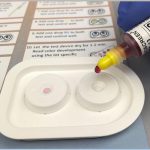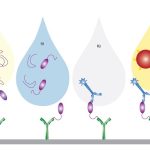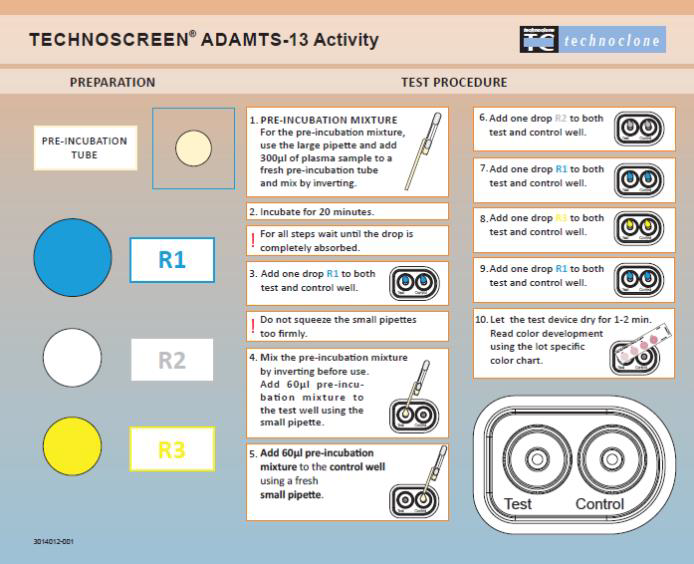
Technoscreen® ADAMTS-13 Activity
$0.00
Techonoscreen® ADAMTS-13 Activity is a semi-quantitative flow-through assay for the determination of ADAMTS-13 activity levels in human citrated plasma. This assay is intended as a screening tool for estimating ADAMTS-13 activity in clinical research studies. Deficiency of ADAMTS-13 needs to be confirmed by a quantitative system. For research use only.
Reagents
The TECHNOSCREEN® ADAMTS-13 Activity contains:
| Reagent / Content | Description | |
|---|---|---|
| 10 x 1 | TECHNOSCREEN® test device | Device with test and control well including membrane and absorbent paper |
| 10 x 1 | TECHNOSCREEN® pre-incubation tubes | Tubes with vWF fragments, lyophilized |
| 1 x 4mL | TECHNOSCREEN® R1 | Reagent 1: Wash solution PBS and detergent, ready to use |
| 1 x 1m | TECHNOSCREEN® R2 | Reagent 2: biotinylated anti-GST antibody, ready to use |
| 1 x 1mL | TECHNOSCREEN® R3 | Reagent 3: streptavidin coated gold particles, ready to use |
| 11 x 1 | Large pipette (300μl) | 300μl single use pipette to transfer plasma sample into pre-incubation tube |
| 22 x 1 | Small pipette (60μl) | 60μl single use pipette to transfer pre-incubation mixture onto test devic |
| 1 x 1 | Short Instruction Pad | Short protocol including stand for pre-incubation tube |
| 1 x 1 | Reference Color Chart | Lot specific color chart with colored zones indicating four levels of ADAMTS-13 activity from 0.0 – 0.8IU/mL. For visual interpretation of results. |
Advantages
- Easy and Fast
- Using an in-house screening assay can lead to significant cost savings in clinical research studies
- Easy test procedure for rapid screening with ready to use reagent
- Reduced time to result
- Large and small pipettes for the pre-incubation mixture included
- Color chart included, for easy interpretation of results
- No instrumentation required
Assay Principle
Sample plasma is incubated with a vWF fragment. ADAMTS-13 specific cleavage of this vWF fragment is then detected with a cleavage site specific antibody by the amount of color development. The color intensity directly correlates with the amount of cleaved substrate and thus with ADAMTS-13 activity level in the plasma sample.
Background
ADAMTS-13
ADAMTS-13 (a disintegrin-like and metalloproteinase with thrombospondin type 1 motif 13) is an enzyme (vWF-cleaving protease or vWF-CP) that specifically cleaves unusually large von Willebrand factor (vWF) multimers, which induce platelet thrombus formation under high shear stress. If the activity of ADAMTS-13 is lowered for some reason, unusually large vWF multimers may accumulate within blood causing thrombosis due to platelet aggregation, which in turn may lead to TTP (thrombotic thrombocytopenic purpura).
Many of the original assays for measuring ADAMTS-13 activity involved using a multimeric vWF substrate that was either plasma-derived or recombinant. These assays are time consuming (from 2 to 4 days) and difficult to reproduce between testing centers. Many of the issues were circumvented by the development vWF peptide substrates, leading to a turn-around time from 1 to 4 hours. ADAMTS-13 substrates (ie, FRET substrates) were eventually developed into commercial kits. However, differences in the technology used for measuring ADAMTS-13 activity in the kits may result in limitations in various products giving discrepant results. Some limitations in any method for measuring ADAMTS-13 activity may be unavoidable; however, lack of interferences and accurate measurement at very low ADAMTS-13 activity are critical in laboratory assays.
Fluorescent assays also have numerous limitations, such as interferences from plasma proteins such as hemoglobin and bilirubin. For example, bilirubin absorbs light at the same wavelengths as the chromophores in FRETS-vWF73, and hemoglobin absorbs at 550 nm and also directly inhibits ADAMTS-13 regardless of the assay method. There is some recent evidence that unconjugated bilirubin can directly inhibit ADAMTS-13 as well. It’s possible to lessen these issues by dilution, but this may result in limiting assay sensitivity, which is critical for ADAMTS-13 assays.
Liquid phase FRET assays are also subject to discrepancies because of cleavage of the ADAMTS-13 substrate (ie, vWF73) by other proteases. For example, the presence of elastase in a sample mixed with the substrate will result in cleavage leading to a measured fluorescent signal, when any peptidyl bond between the 2 fluorescent dyes is cleaved. While levels of ADAMTS-13 in the plasma sample will always vary depending on the disease condition (which may result in abnormal levels of many different proteases and other proteins), protease interference can be reduced during the actual assay if the ADAMTS-13 is first captured on a plate followed by washing before adding the FRET substrate. ELISA plate-based methods can reduce or eliminate these interferences, as the sample is washed away.
An additional alternative is to avoid fluorescent assays using a standard chromogenic ELISA method (HRP/TMB reagents) that requires standard ELISA equipment rather than a fluorescent reader. Peptide vWF substrates are still used but a unique method that captures the substrate on the plate and, with ADAMTS-13 from the sample, cleaves the peptide to expose a neo-epitope. This new epitope can be recognized by a specific antibody allowing ADAMTS-13 activity to be determined by ELISA. A high sample dilution can avoid bilirubin and hemoglobin interference. In addition, protease interference is minimized using an antibody very specific to the ADAMTS-13 cleavage site (Tyr1605-Met1606), and most proteases (ie, elastase) cleave a different site (ie, M1606-V1607 or V1607-T1608). Only cathepsin G may have the same cleavage site. Using this type of assay, sensitivity down to 0.5% ADAMTS-13 activity can be reached.



